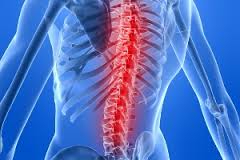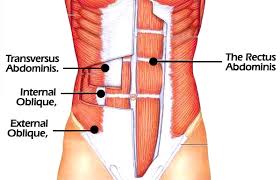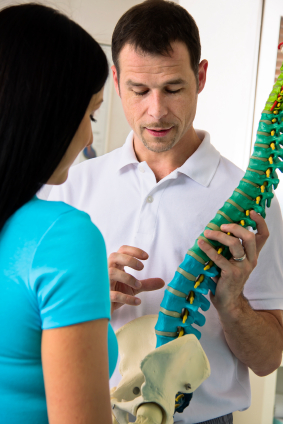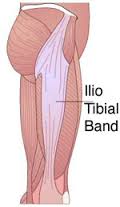Written by Chelsea on June 29, 2016 |

Last week we discussed the “core” and the importance of two specific muscles that make up this group in order to provide spinal stability. We looked specifically last week at the transverse abdominis, and this week we will talk about the multifidus. Continue Reading »
Written by Chelsea on June 22, 2016 |
 Whenever someone experiences pain in their low back, a phrase often heard is that they need a stronger “core.” The term “core” refers to several muscles primarily in the back/lumbar spine, abdominal region, and pelvis. When looking at the low back specifically, there is less bony stability than in the thoracic spine, which forces our muscles to provide the support needed to protect the low back. Two of the most important muscles in the core that provide this support are the transverse abdominis and the multifidus. These muscles act as a “back brace” (in addition to other core muscles) to help provide adequate spinal stability.
Whenever someone experiences pain in their low back, a phrase often heard is that they need a stronger “core.” The term “core” refers to several muscles primarily in the back/lumbar spine, abdominal region, and pelvis. When looking at the low back specifically, there is less bony stability than in the thoracic spine, which forces our muscles to provide the support needed to protect the low back. Two of the most important muscles in the core that provide this support are the transverse abdominis and the multifidus. These muscles act as a “back brace” (in addition to other core muscles) to help provide adequate spinal stability.
Continue Reading »
Written by Chelsea on June 15, 2016 |
 Walking into a physical therapy evaluation can sometimes seem a little overwhelming if you do not know what to expect and have never completed therapy before. Although each therapist treats a little bit differently, here are some general guidelines that you can expect on your very first visit with a therapist at ProActive Physical Therapy.
Walking into a physical therapy evaluation can sometimes seem a little overwhelming if you do not know what to expect and have never completed therapy before. Although each therapist treats a little bit differently, here are some general guidelines that you can expect on your very first visit with a therapist at ProActive Physical Therapy.
Continue Reading »
Written by Chelsea on June 8, 2016 |
 The IT-band (or iliotibial band) runs from the top of the pelvis, or ilium, and extends all the way down the outside of the thigh to the top of the lower leg, or tibia. In the thigh, it also connects to your glutes and tensor fascia latae muscles, and as it travels downward, has fibers that blend into your knee cap as well. The IT-band is made up of very dense connective tissue, making it extremely strong to provide stability during weight bearing activity. Functionally speaking, when we bend and straighten our knee repetitively (i.e. during running), the band slides back and forth and can sometimes cause localized irritation or inflammation. This can result in a very common sports related injury called IT-band syndrome. Symptoms can be felt anywhere along the IT-band, but usually occur closer to the attachment near the lateral knee. Muscle imbalances, like tight hip flexors or weak hip rotators, can often times be the cause of developing IT-band syndrome.
The IT-band (or iliotibial band) runs from the top of the pelvis, or ilium, and extends all the way down the outside of the thigh to the top of the lower leg, or tibia. In the thigh, it also connects to your glutes and tensor fascia latae muscles, and as it travels downward, has fibers that blend into your knee cap as well. The IT-band is made up of very dense connective tissue, making it extremely strong to provide stability during weight bearing activity. Functionally speaking, when we bend and straighten our knee repetitively (i.e. during running), the band slides back and forth and can sometimes cause localized irritation or inflammation. This can result in a very common sports related injury called IT-band syndrome. Symptoms can be felt anywhere along the IT-band, but usually occur closer to the attachment near the lateral knee. Muscle imbalances, like tight hip flexors or weak hip rotators, can often times be the cause of developing IT-band syndrome.
So what are the best ways to treat IT-band syndrome?
First, make sure to address any muscle imbalances by getting into a regular stretching and strengthening routine. A physical therapist can help identify specifically which muscle groups you should address to improve overall mobility and stability. Make sure you address the overall mobility of the IT-band as well by using products like a foam roller or massage stick. These products can be used regularly to help treat and prevent further irritation.
Secondly, make sure you have proper footwear. A lack of proper support in your foot can affect the forces in in your knee and hip and contribute to muscle imbalances related to IT-band syndrome.
Finally, make sure you get into a routine of regularly icing the affected area for 15-20 minutes to treat any localized inflammation.



 Whenever someone experiences pain in their low back, a phrase often heard is that they need a stronger “core.” The term “core” refers to several muscles primarily in the back/lumbar spine, abdominal region, and pelvis. When looking at the low back specifically, there is less bony stability than in the thoracic spine, which forces our muscles to provide the support needed to protect the low back. Two of the most important muscles in the core that provide this support are the transverse abdominis and the multifidus. These muscles act as a “back brace” (in addition to other core muscles) to help provide adequate spinal stability.
Whenever someone experiences pain in their low back, a phrase often heard is that they need a stronger “core.” The term “core” refers to several muscles primarily in the back/lumbar spine, abdominal region, and pelvis. When looking at the low back specifically, there is less bony stability than in the thoracic spine, which forces our muscles to provide the support needed to protect the low back. Two of the most important muscles in the core that provide this support are the transverse abdominis and the multifidus. These muscles act as a “back brace” (in addition to other core muscles) to help provide adequate spinal stability. Walking into a physical therapy evaluation can sometimes seem a little overwhelming if you do not know what to expect and have never completed therapy before. Although each therapist treats a little bit differently, here are some general guidelines that you can expect on your very first visit with a therapist at ProActive Physical Therapy.
Walking into a physical therapy evaluation can sometimes seem a little overwhelming if you do not know what to expect and have never completed therapy before. Although each therapist treats a little bit differently, here are some general guidelines that you can expect on your very first visit with a therapist at ProActive Physical Therapy. The IT-band (or iliotibial band) runs from the top of the pelvis, or ilium, and extends all the way down the outside of the thigh to the top of the lower leg, or tibia. In the thigh, it also connects to your glutes and tensor fascia latae muscles, and as it travels downward, has fibers that blend into your knee cap as well. The IT-band is made up of very dense connective tissue, making it extremely strong to provide stability during weight bearing activity. Functionally speaking, when we bend and straighten our knee repetitively (i.e. during running), the band slides back and forth and can sometimes cause localized irritation or inflammation. This can result in a very common sports related injury called IT-band syndrome. Symptoms can be felt anywhere along the IT-band, but usually occur closer to the attachment near the lateral knee. Muscle imbalances, like tight hip flexors or weak hip rotators, can often times be the cause of developing IT-band syndrome.
The IT-band (or iliotibial band) runs from the top of the pelvis, or ilium, and extends all the way down the outside of the thigh to the top of the lower leg, or tibia. In the thigh, it also connects to your glutes and tensor fascia latae muscles, and as it travels downward, has fibers that blend into your knee cap as well. The IT-band is made up of very dense connective tissue, making it extremely strong to provide stability during weight bearing activity. Functionally speaking, when we bend and straighten our knee repetitively (i.e. during running), the band slides back and forth and can sometimes cause localized irritation or inflammation. This can result in a very common sports related injury called IT-band syndrome. Symptoms can be felt anywhere along the IT-band, but usually occur closer to the attachment near the lateral knee. Muscle imbalances, like tight hip flexors or weak hip rotators, can often times be the cause of developing IT-band syndrome.